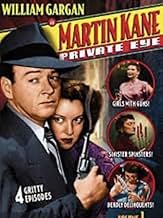Martin Kane, Private Eye is a ghost from television's prehistoric era. It debuted in 1949 and ran until 1954, airing on NBC Thursday nights at 10; I have vague memories of being allowed to see now and again it as a small child. Something about it stuck with me, and when I found selected episodes from a few of its seasons on videotape, I bit.
The title character changed over the seasons, drawing from a roster of Hollywood has-beens. William Gargan was the first Kane (no reference to the Orson Welles movie seems to have been intended), followed by Lloyd Nolan, Lee Tracy and Mark Stevens. Generally, Kane was the only recognizable member of the cast, the others consisting of regulars playing police investigators and occasional players drawn, I assume, from the lower echelons of New York's theater world, and looking incredulous at actually having found gainful employment in the fledgling medium. (In one episode, Una O'Connor gives what must have been the performance of her career as a deranged spinster with a carving knife.)
One other regular must be mentioned, however, as he was essential to the show's existence. Walter Kinsella played Happy McMann, proprietor of a tobacco shop which served as the story's home base. This was convenient as the show's sponsor was a tobacco company, advertising their now defunct brands such as Tweed pipe tobacco and King Sano cigarettes. Kane himself was always buying a pouch and discussing its merits with McMann, and bit players strolled in to look for a smoother-burning tobacco or a smoke with less nicotine. Martin Kane, Private Eye belongs to the prehistory of product placement, too, using a formula which derived from the radio serials bankrolled by sole sponsors.
The show was filmed live, and does it show. The characters all overact in the stagey way that indicates unfamiliarity with cameras, flub their lines, and desperately try to cover up. The plots are rudimentary, centering on such formulas as con-games perpetrated by Eastern mystics and shady fortune-tellers. The sets are bare-boned and not much helped by the lighting, which ranges from the harsh to the stygian (sometimes in the same set-up; candle flames, which abound, dance in a pitch-black nimbus).
Seen from today's vantage point, Martin Kane, Private Eye makes Magnum, P.I. look like a masterpiece and other shows like Murder, She Wrote and Diagnosis: Murder look pretty good. But there's a lot of nostalgic appeal in watching those desperate old troupers try to make the new-fangled medium of television work. Martin Kane isn't as spooky as I remembered it - it isn't spooky at all, except as a cautionary tale about lives lived too long in show business. But it's fun to watch because of its very primitiveness.

























